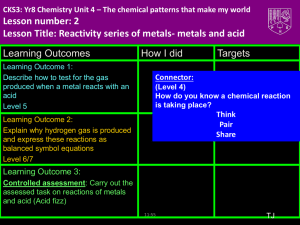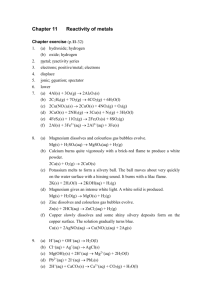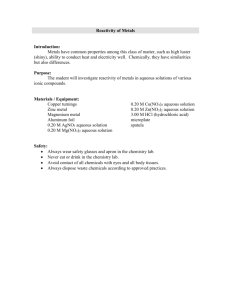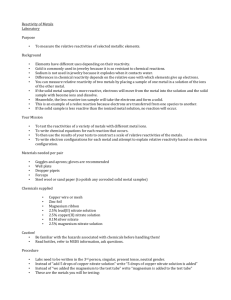SCH 3U activity series of metals and nonmetals and single d
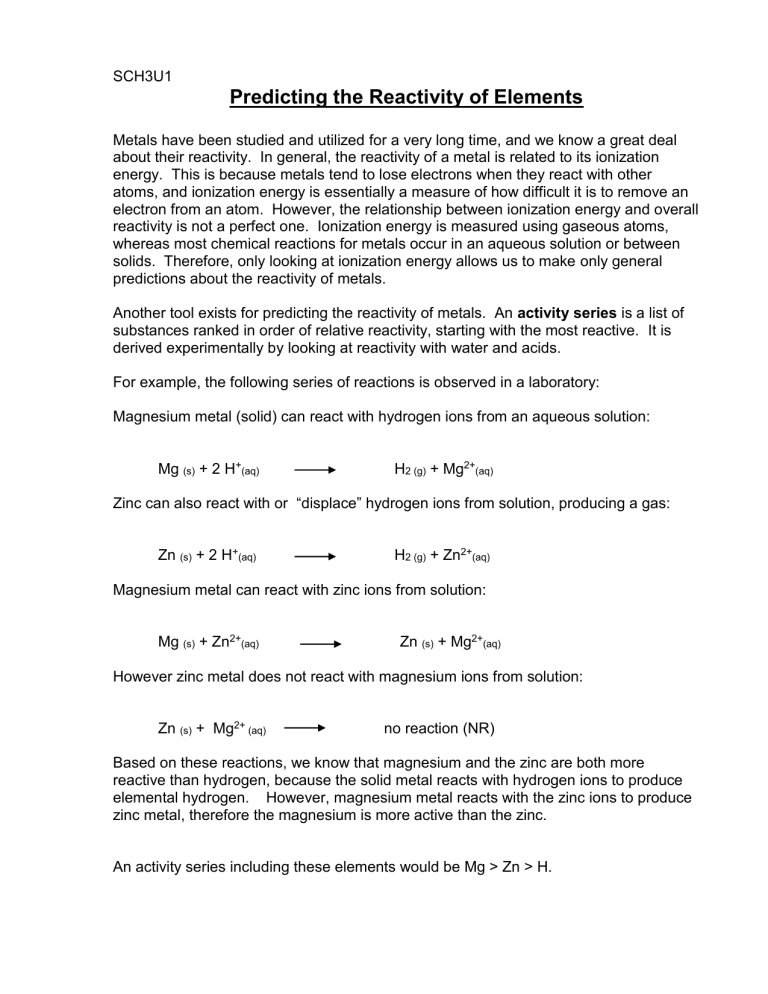
SCH3U1
Predicting the Reactivity of Elements
Metals have been studied and utilized for a very long time, and we know a great deal about their reactivity. In general, the reactivity of a metal is related to its ionization energy. This is because metals tend to lose electrons when they react with other atoms, and ionization energy is essentially a measure of how difficult it is to remove an electron from an atom. However, the relationship between ionization energy and overall reactivity is not a perfect one. Ionization energy is measured using gaseous atoms, whereas most chemical reactions for metals occur in an aqueous solution or between solids. Therefore, only looking at ionization energy allows us to make only general predictions about the reactivity of metals.
Another tool exists for predicting the reactivity of metals. An activity series is a list of substances ranked in order of relative reactivity, starting with the most reactive. It is derived experimentally by looking at reactivity with water and acids.
For example, the following series of reactions is observed in a laboratory:
Magnesium metal (solid) can react with hydrogen ions from an aqueous solution:
Mg
(s)
+ 2 H +
(aq)
H
2 (g)
+ Mg 2+
(aq)
Zinc can also react with or “displace” hydrogen ions from solution, producing a gas:
Zn
(s)
+ 2 H +
(aq)
H
2 (g)
+ Zn 2+
(aq)
Magnesium metal can react with zinc ions from solution:
Mg
(s)
+ Zn 2+
(aq)
Zn
(s)
+ Mg 2+
(aq)
However zinc metal does not react with magnesium ions from solution:
Zn
(s)
+ Mg 2+
(aq) no reaction (NR)
Based on these reactions, we know that magnesium and the zinc are both more reactive than hydrogen, because the solid metal reacts with hydrogen ions to produce elemental hydrogen. However, magnesium metal reacts with the zinc ions to produce zinc metal, therefore the magnesium is more active than the zinc.
An activity series including these elements would be Mg > Zn > H.
Very
Active
Metals
The following activity series built up in a similar way.
The most active metals are at the top of the table; the least active are at the bottom.
Metal
K Most
Reactive
Na
Li
Ba
Ca
Mg
Al
Zn
Cr
Fe
Never found free in nature
Will react with cold water to produce base and H
2(g)
Form extremely stable oxides
Form very stable oxides
Cd
Co
Ni
Sn
Pb
H
Rarely found free in nature
Will react with very hot water or acid to produce
H
2(g)
Cu
Au
Pt Least
Reactive
No reaction with water or acid.
Form stable oxides
Noble
Metals
Ag
Hg Often found free in nature
Usually found free in nature
Unstable oxides, decomposed by heat alone
Many predictions about metals can be made using the activity series.
1. The metals are listed in order of decreasing reactivity. The higher on the series a metal is, the more likely it is to react with another element, such as oxygen, sulfur or the halogens. Therefore, elements lower on the list are likely to be found free in nature, while those higher on the list are not.
2. The higher a metal is on the series, the more readily it will form a compound, and the more stable the compound will be once it is formed.
3. Any metal above hydrogen will react with an acid to form hydrogen gas. zinc + hydrochloric acid barium + water zinc chloride + hydrogen gas
4. Any metal above magnesium will react with cold water to produce a base and hydrogen gas. barium hydroxide + hydrogen gas
5. Any metal above lead will react with water to form hydrogen gas. However, metals between hydrogen and magnesium will need heat to increase the reaction rate to the point where it is noticeable and will only form an oxide. The lower on the series it is, the more heat will be needed.
+ heat magnesium + water magnesium oxide + hydrogen gas
6. You can predict what will happen if a metal is placed in a solution of a metal salt
(e.g. KCl). Each metal is able to displace any element below it on the series from a solution. This is called a single displacement reactions . magnesium + zinc iodide zinc + magnesium iodide
Mg + ZnI
2
Zn + MgI
2
Reactivity Series of Non-metals
The reactivity of non-metals is related to electron affinity. With a higher electron affinity, non-metals have a greater the tendency to gain electrons and form a negative ion.
A non-metal reactivity series has also been developed.
Most reactive F > Cl > Br > O > I > S Least reactive
Predictions about the reactivity of non-metals work in the same way as for the metals.
A non-metal will displace any non-metal from solution that is below it on the series. fluorine + sodium bromide sodium fluoride + bromine bromine + sodium fluoride N.R.
Problems with the Activity Series
The series works well as long as the reactions being predicted occur at room temperature and in aqueous solution. It is not difficult to find reactions that are at odds with the metal and non-metal activity series under other conditions.
There are other complications too. For example, aluminum would be expected to displace hydrogen from steam, but in fact it won't unless the aluminum oxide film on its surface is scrubbed off. Copper cannot displace hydrogen from acids, but it does react with acids such as nitric acid and sulfuric acid because they can act as oxidizing agents.
Therefore, the series are used as predictive tools and not definitive rules.
Examples:
Predict if a reaction will occur between the following reactants. If a reaction occurs, write a word equation and balanced chemical equation. If no reaction occurs, write NR
(no reaction). i) calcium + oxygen ii) aluminum + water iii) aluminum bromide + gold iv) silver chloride + zinc v) sodium iodide + fluorine gas
Activity Series of Metals – Questions
1. a) What group contain the most reactive metals? ________________ b) What group contains the most reactive non-metals? __________________
2. Complete the following general reaction equations: metal + water i) ii) metal + acid
3. Use the activity series to predict which of the following combinations would result in the production of hydrogen gas. If a reaction will occur, place a
beside it. If no reaction is predicted, write NR . a) iron + hydrochloric acid f) platinum + hydrochloric acid b) potassium + water c) silver + hydrosulfuric acid g) copper + phosphoric acid h) aluminum + water
4. For each pair of metals, circle the metal that would be expected to react most rapidly with water. d) zinc + sulphuric acid e) calcium + water i) zinc + nitric acid j) gold + sulfuric acid a) aluminum or iron b) zinc or nickel c) calcium or magnesium
5. For each of the combinations of metal and solution listed below, predict if a single displacement reaction will occurs. If a reaction will occur, place a
beside it. If no reaction is expected, write NR . a) lead + tin (II) chloride b) iron + magnesium oxide c) aluminum + mercury (I) oxide d) calcium + copper (II) chloride e) lead + copper (II) sulfate f) sodium + iron (III) oxide
Answer the following on a separate page. g) tin + sodium chloride h) lead + potassium nitrate i) iron + silver chloride j) silver + gold (III) bromide l) gold + copper (II) sulfate k) aluminum + nickel (II) sulfate
6. Describe what you expect will happen to an iron nail that is dipped into: a) a solution of copper (II) sulfate? b) a solution of aluminum sulfate?
7. For each of the following, predict whether or not a displacement reaction would occur. If a reaction will occur, complete the word equation. If a reaction does not occur, write NR. a) calcium + potassium sulphate e) zinc + silver nitrate b) zinc + aluminum oxide c) aluminum + magnesium carbonate d) sodium + water f) magnesium + hydrochloric acid g) potassium + iron (II) chloride h) sodium + zinc bromide
8. For each of the following, predict whether or not a single displacement reaction will occur. If a reaction occurs, write the word equation. If a reaction does not occur, write no reaction (NR). a) fluorine + potassium chloride c) bromine+ calcium sulfide b) chlorine + aluminum bromide d) chlorine + potassium oxide

